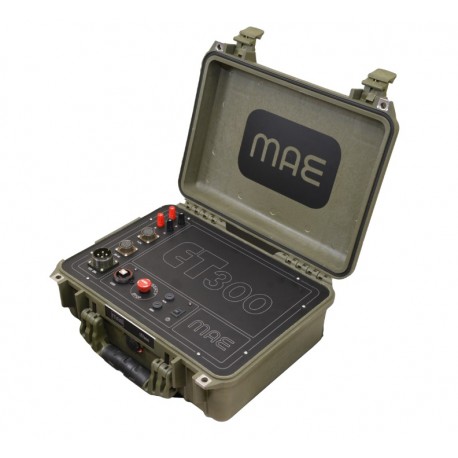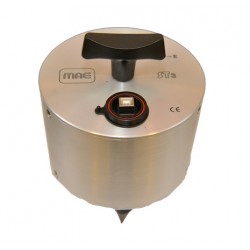- Inicio
- Quem somos
- Produtos
-
Marcas
-
Produtos por Medida
- Analisadores Vibração
- Bombas Peristálticas
- Fluxo de Ar
- CO Monóxido Carbono
- Contadores Geiger
- Destiladores
- Espectrofotometria
- Esterilização
- Fluorescência
- GEOTECNICS
- Umidade do Solo
- Índice de área foliar
- Chuva (pluviométrico)
- Meteorologia
- Nível de Água
- O2 oxigênio
- pH
- Pressão Diferencial
- Radiação
- Salinidade/Condutivid.
- Telemetria
- Velocidade do Ar
- Umidade Relativa
- Veterinary
- PILHAS DE COMBUSTÍVEL
- Analisadores de Redes
- Calibradores
- CAUDAL DE ÁGUA
- Cor / Colorímetro
- Contadores Partículas
- Direçao Vento
- Espectrometria
- Evapotranspiração
- Fotossíntese
- Rachaduras edifícios
- Inspeção de Tubos
- Luz Quântica
- Movimento e GPS
- Nível de diesel
- Oxigênio Dissolvido DO
- Pressão Atmosférica
- Radon
- Savia/Fluxo de Savia
- Temperatura
MAE ET300 Georresistivímetro Multicanal 24-48 Canais
Vantagens:
► Paralelização de medições para as configurações pólo-dipolo, pólo-pólo, dipolo-dipolo e tridimensional
► Resolução de 24 bits
► Pseudosecção em tempo real
► Permite levantamentos VES e tomográficos.
Vantagens da arquitetura de aquisição de dados MAE ET300:
- Reduza drasticamente o tempo necessário para completar uma pesquisa.
- Possibilidade de dar resposta a investigações que anteriormente eram impensáveis, devido ao elevado número de medidas necessárias
- Possibilidade de repetir as medições várias vezes para minimizar a incerteza, durante o mesmo tempo medido
- Menor consumo de energia
- Registo do desvio padrão para cada medição
- Representação gráfica com barras de erro dos pontos de medição
- Visualização em tempo real da pseudosecção de resistividade
- Disponibilidade de função de repetição automática das medições com percentagem de erro superior a um limite configurável.
O ET300 é um novo medidor de georresistividade compacto para SEV e prospeção geoelétrica multieletrodo com 24 ou 48 elétrodos.
A principal característica desta instrumentação é a máxima versatilidade de utilização aliada à elevada velocidade de execução de levantamentos, tanto 2D como 3D. O ET300 é gerido através de um portátil ou tablet normal através de ligação USB.
Está equipado com a função "preview" que permite ao utilizador visualizar uma pré-visualização da pseudosecção derivada do comboio de dados recentemente adquirido diretamente no terreno.
A instrumentação realiza a medição ou o ciclo de medição definido pelo utilizador em modo automático.
Uma vez concluído o ciclo de medição, os dados adquiridos podem ser imediatamente visualizados através da função "preview", cuja utilização permite ao operador verificar imediatamente os dados registados e processá-los com o respectivo software de processamento de dados.
Em geral:
Tecnologia ADC: ADC Delta-Sigma de 24 bits
Número de elétrodos: 24-48 (com 20 canais)
Configurações da matriz: 1D, 2D, 3D
Medições: Autopotencial, resistividade, polarização induzida
Dimensão: 40x33x17cm
Peso: 6,3kg
Compatibilidade de exportação: RESinv, ERTlab, ZondRES, MAE
Função roll-along: controlada por software
Pseudosecção em tempo real: 1D, 2D e 3D
Gerador de sequências: 1D, 2D e 3D
Caso: IP67
Condição ambiental: -20°C/90°C
Fonte de alimentação: Bateria externa de 12V, sugerida 100Ah
Consumo médio: 0,5A, pico até 50A
Saída:
Potência de saída: 300 W
Tensão de saída: ±50V, ±100V, ±200V, ±400V, ±800V
Corrente de saída: até 6A a 50V, até 0,375A a 800V
Diagrama de energização: Personalizado a partir dos 250ms
Precisão: ±0,2 μA
Precisão: <0,2%
Entrada:
Estratégia de medições: Paralela
Tensão de entrada: ±25V
Precisão: 1,5 μV vs escala completa
Precisão: <0,2%
Impedância de entrada: 2,5MΩ
Empilhamento e redução de ruído: Até 255
Filtro de entalhe de entrada: 50 Hz
Ajuste de auto potencial: Automático
Janelas IP: Até 20 janelas num intervalo de 20ms
This survey method calculates ground resistivity based on voltage difference (d.d.p.) measurements. The process involves introducing an electric field into the ground using current electrodes and measuring the d.d.p. at separate measurement electrodes. Using Ohm's second law, the resistivity value is determined, reflecting the intrinsic properties of the material. Since rocks are naturally resistive, variations in resistivity are primarily due to the presence of water in varying amounts. In 2D-3D electrical tomography, electrode grids (16, 32, 64, 128, etc.) are fixed into the ground at regular intervals. These electrodes are connected to commutation boxes that automatically select the measuring and current electrodes, performing all possible combinations. The system generates numerous measurements based on the number of electrodes and the geometric configuration used. The tomographic inversion of this data produces a 2D or 3D reconstruction of the ground, allowing the identification of anomalies such as cavities, water bodies, and their shapes, sizes, and spatial distribution. Multi-electrode Geoelectrical Prospecting+
.jpg)
V.E.S. Vertical Electrical Survey+
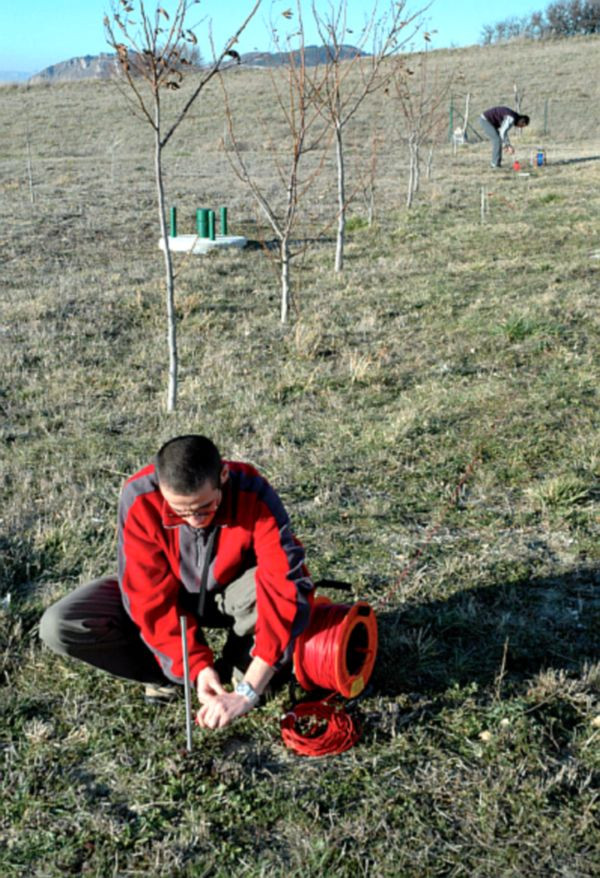
Induced Polarization (IP) is an electrical phenomenon that occurs within material media. In the time domain, it is observed as chargeability, which happens when stress is released after the interruption of a step-type electric current. In the frequency domain, it involves the dispersion of electrical resistivity as the frequency of an alternating current changes. IP sources are primarily linked to redox processes at the interfaces between metal grains and interstitial fluids (electrode polarization). Another significant IP source is the accumulation of ions in moving electrolytes due to variations in mobility along the path (electro-kinetic polarization). Through tomographic inversion of surface data, the resulting images reflect chargeability, enabling the identification of areas with potential hydrocarbon accumulations or other significant concentrations. Chargeability is directly proportional to the amount of charge stored by the lithotype, indicating the concentration of conductive materials in the multi-electrode area. Induced Polarization Measurement+
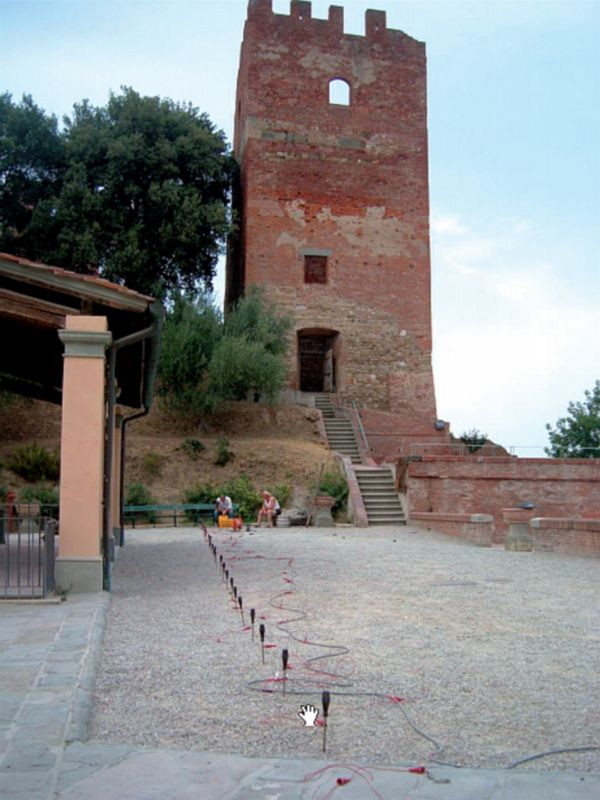
The Spontaneous Potential (SP) method involves measuring potential differences on the surface that are associated with natural electric fields, which are linked to the underground flow of aqueous electrolytic solutions in porous media. By analyzing SP anomalies on the surface, the intensity and position of ionic charge concentrations of both polarities can be determined. The test involves placing two electrodes: one near the measurement station and the other moved along subsequent stations on the line. Alternatively, both electrodes can be moved while maintaining a consistent interval between them, mapping the ground based on spontaneous potential variations. This method is particularly useful in mining for locating sulfides and graphite, as well as in archaeology. Underground water flows can be influenced by archaeological structures, which may act as drains or obstacles. By identifying SP anomalies, it is possible to indirectly detect these underground structures. Spontaneous Potential Measurement+
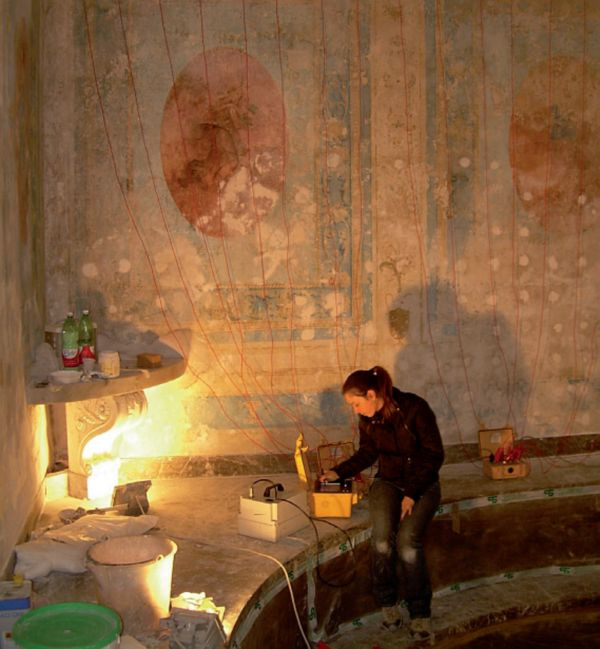
.jpg)
- Tipo de Instrumento
- Georresistivímetro
